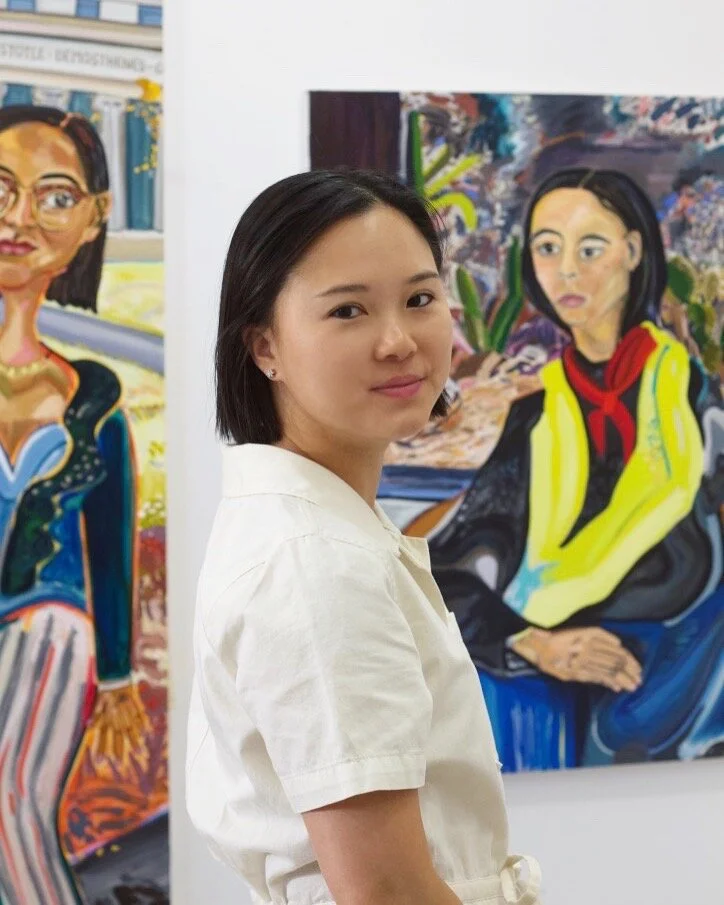Art Convo with Monica Ikegwu: Painting Young Black Subjects with Truth and Individuality
Courtesy of the artist.
I stan hard for Monica Ikegwu’s vibrant oil-based paintings. The subjects in her canvases have radiant brown skin and slick monochromatic fits. The Baltimore-based painter is repped by Band of Vices and Galerie Myrtis, and only more praise and recognition await, as her career unfolds. The current New York Academy of Art grad student shares positive vibes, being focused on her art, and depicting Black folks in truthful and gorgeous ways.
How are you feeling at this moment?
At this moment, I would say that I'm still adapting to the new normal, but overall i'm feeling good!
How have you balanced self-care and your art practice during these quarantined months?
While in quarantine my life was moving in a recurring cycle. I barely went out so I decided that I would use the quarantine time to make a lot of work. Almost everyday it started with me painting from the late morning until the afternoon or night. Only after I was done painting would I then have time for myself. At night was when I would take care of all my personal needs. I would watch TV, eat, exercise, wash my hair, etc. Painting came first and then I took care of myself. That cycle went on for months, and it wasn't bad. It helped me keep focus and schedule what I needed to do for each day.
I'm really digging your color palette, your color choices are rich and deep. I notice your subjects are usually dressed in cool monochromatic outfits. Can you expand?
Color is important to me. I use color also as a way to draw attention. The highly saturated and vibrant colors that I use are meant to attract people. When placed on a wall I want my paintings to draw people in and hold their attention. I try to bring out as much color as possible, from the skin tone to the reflective light. When I first start painting I always start with the face and areas that have skin showing. From there I can then determine which color I want to use for the whole piece. I typically choose a color that best compliments the person's skin tone, and from that one hue I can work within a range of different variations that stem from that one color choice. The monochromatic choice of color was also a way for me to unify the whole piece as one.
Akia, oil paint on canvas, 2020. Courtesy of the artist.
We Gon' See You Later, oil paint on canvas, 2019. Courtesy of the artist.
Your paintings feature young Black and Brown subjects and their skin tones are so luminous. Can you talk about the power of representation in your work?
For me I think that representation matters because it makes people feel seen. When you're in a space, but none of the people look like you, it tends to make people feel unwelcome and a little uncomfortable. During shows it was always nice to hear that people felt like they knew the subjects in my paintings. Sometimes at show openings I’d hear people say “he looks like someone I know” or “she looks just like my sister.” Occasionally hearing those remarks of familiarity lets me know that people are relating to the work. I've even had some high school kids look at my work before and say to each other “hey, that was us the other day.” Having relation to the work opens up people to the world of art because they can see themselves within it. Also, I wanted to present African American people in a positive light. The people that I paint are actual people that I have pose for me. I allow them to choose their own style and pose. I want them to have the freedom to dictate their own image. With that starting point, I then present an accurate depiction of people that shows individuality and all of our differences. It's a way to oppose the structured stereotypes that people have created about African Americans.
Olivia, oil paint on canvas, 2020. Courtesy of the artist.
“The people that I paint are actual people that I have pose for me. I allow them to choose their own style and pose. I want them to have the freedom to dictate their own image. With that starting point, I then present an accurate depiction of people that shows individuality and all of our differences. It's a way to oppose the structured stereotypes that people have created about African Americans.”
Once Over, oil paint on canvas, 2019. Courtesy of the artist.
I know times are uncertain, but feel free to share upcoming projects or other projects that you're excited about.
Future shows are still in the process and undecided because of COVID-19, but right now I’ve just started grad school. I'll be pretty busy with school for the next two years, but I'm hoping to take the new information that I gain to create more work that is new and exciting.









